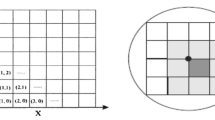Abstract
Although broadcasting using tree structure established in a network is a well known and widely used technique, it is typically claimed to be inappropriate for ad hoc networks, being the maintained tree very sensitive to network changes. On the contrary this paper presents an efficient tree based broadcasting scheme, which is reliable and stable even in case of the ever changing network structure of the ad hoc networks.
To achieve this, first, a novel method is presented to maintain a spanning tree in an ad hoc network in a fully distributed, on-line and asynchronous way. Once the tree is established the broadcast itself is performed based on this tree. Some further improvements on the basic algorithm are also presented that reduce the resource requirements even more, increase the stability of the tree, enable the mobility of the nodes to be taken into account and make the method more configurable.
As it is shown by simulation, the obtained broadcast scheme is stable, reliable and it uses small amount of resources: the acyclic structure of the broadcast tree ensures that the nodes get the broadcast messages only once, so the broadcast needs little bandwidth and the nodes need not store the recent broadcast messages, reducing the computational and memory requirements.
As a byproduct a technique is proposed to measure the mobility of the nodes. This technique needs no additional GPS device or any geographical information but it is based on the stability of the links of the node.
Similar content being viewed by others
References
A. Adams, J. Nicholas and W. Siadak, Protocol independent multicast—dense mode (PIM-DM): Protocol specification (Revised), IETF Internet-Draft, draft-ietf-pim-dm-new-v2-02.txt, work in progress, October 2002.
A. Ballardie, P. Francis and J. Crowcroft, Core based trees (CBT) an architecture for scalable inter-domain multicast routing, SIGCOMM’93 (San Francisco, 1993) pp. 85–95.
D. Estrin et al., Protocol independent multicast—sparse mode (PIM-SM): Protocol specification, RFC 2362, June 1998.
R.G. Gallager, P.A. Humblet and P.M. Spira, A distributed algorithm for minimum weight spanning trees, ACM Trans. on Programming Languages and Systems 5(1) (1983) 66–77.
Z.J. Haas, M.R. Pearlman and P. Samar, The bordercast resolution protocol (BRP) for ad hoc networks, IETF Internet-Draft, draft-ietf-manet-zone-brp-01.txt, work in progress, June 2001.
IEEE Specification 820.1d “MAC Bridges” D9, July 14, 1989.
Ch. Lee, M.H. Ammar and J.E. Burns, An improved leader election protocol in multi-hop radio networks, in: International Conference On Computer Communication (Seoul, Korea, 1995).
H. Lim and C. Kim, Multicast tree construction and flooding in wireless ad hoc networks, in: Proc. 3rd ACM International Workshop on Modeling, Analysis and Simulation of Wireless and Mobile Systems (2000) pp. 61–68.
J. Moy, Multicast routing extensions for OSPF, CACM 37 (Aug 1994) 61–66.
S.-Y. Ni, Y.-C. Tseng, Y.-S. Chen and J.-P. Sheu, The broacast storm problem in a mobile ad hoc network, in: Proc. ACM/IEEE MobiCom August 1999) pp. 151–162.
N. Nikaein, H. Labiod and C. Bonnet, DDR: distributed dynamic routing algorithm for mobile ad hoc networks, in: International Conference on Mobile Computing and Networking (2000) pp. 19–27.
C.E. Perkins, E.M. Belding-Royer and S.R. Das, IP flooding in ad hoc mobile networks, IETF Internet-Draft, draft-ietf-manet-bcast-00.txt, work in progress, 14 November 2001.
C. Perkins, E. Royer and S. Das, Ad hoc on-demand distance vector (AODV) routing, IETF Internet-Draft, draft-ietf-manet-aodv-11.txt, work in progress, Aug 2002.
S. Radhakrishnan, N.S.V. Rao G. Racherla, C.N. Sekharan and S.G. Batsell, DST—a routing protocol for ad hoc networks using distributed spanning trees, in: IEEE Wireless Communications and Networking Conference (1999) pp. 100–104.
I. Stojmenovic, M. Seddigh and J. Zunic, Internal node based broadcasting algorithms in wireless networks, in: Proceedings of the Hawaii Int. Conf. on System Sciences (Jan. 2001).
J. Sucec and I. Marsic, An efficient distributed network-wide broadcast algorithm for mobile ad hoc networks, CAIP Technical Report, TR-248, July 2000.
D. Waitzman, C. Partridge and S. Deering, Distance vector multicast routing protocol, RFC 1075, November 1988.
P.-J. Wan, K.M. Alzoubi and O. Frieder, Distributed construction of connected dominating set in wireless ad hoc networks, in: IEEE INFOCOM (New York, June 2002).
Author information
Authors and Affiliations
Corresponding author
Additional information
Alpár Jüttner received his M. Sc. degree in 1998 at the Eötvös Loránd University of Budapest, where he is currently working on his Ph. D. at Operational Research Departement. He also works as a research fellow at Ericsson Traffic Analysis and Network Performance Laboratory in Budapest, Hungary. His main interests are combinatorial optimization and its applications.
Ádám Magi received his M. Sc. degree in 1996 at the Technical University of Budapest in Electrical Engineering. He is currently working on his Ph. D. there. He also works as a research fellow at Ericsson Traffic Analysis and Network Performance Laboratory in Budapest, Hungary. His main interests are mobile ad hoc networks and routing in telecommunication networks.
Rights and permissions
About this article
Cite this article
Jüttner, A., Magi, Á. Tree Based Broadcast in Ad Hoc Networks. Mobile Netw Appl 10, 753–762 (2005). https://doi.org/10.1007/s11036-005-3368-5
Issue Date:
DOI: https://doi.org/10.1007/s11036-005-3368-5




